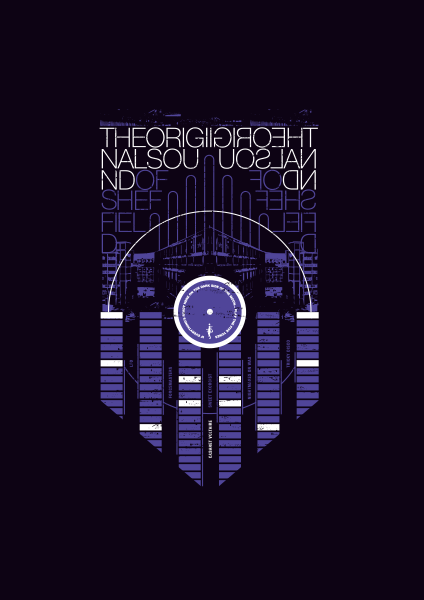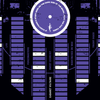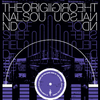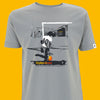The Original Sound of SheffieldCombining Red and Blue
Sheffield resides in a natural amphitheatre created by seven hills and the confluence of five rivers. It is widely considered one of the greenest cities in Europe containing 150 woodlands and public parks. With an estimated two million trees, it has more trees per person than any other city in Europe.
In contrast, it is home to the largest listed (Grade II*) structure in Europe. Park Hill, otherwise known as 'streets in the sky' is a concrete monolith, which opened in 1961. The building covers an area of 17 acres and currently contains around 1,000 flats, the whole site covers 32 acres. It is an example of Brutalist architecture. Derived from the word 'brut', French for raw, the style is predominantly concrete in its rawest form. It is said to be one of the most ambitious inner-city housing projects of its era.
Sheffield was once famed globally for producing the most specialist steels in the world. It became identified as the 'Steel City' and went from being an affluent, industrial powerhouse, to a city synonymous with poverty in the course of a century or so. Margaret Thatcher's systematic dismantling of the manufacturing and steel industry during the late 1970s and 80s, with its associated mass job-shedding, meant that unemployment was rampant at the time. Facing a legacy of declining heavy industry, the city was forced to alter its economic trajectory. To claw its way out of recession, Sheffield had to diversify.
The Sheffield music scene had been steadily producing successful acts since the 1970s, with a particularly rich tradition in electronic music. Cabaret Voltaire, formed in 1973 and are credited with influencing the electronic culture of the Sheffield musical scene. By the mid 80s, Sheffield's electronic acts included Vice Versa, Clock DVA, Chakk and, of course, The Human League and Heaven 17.
During the 1980s, a scheme was introduced, and promoted by the ‘then’ Conservative government indented to glorify the virtues of self employment. Against a backdrop of massive 'underemployment' throughout Britain, a weekly sum of £40 (for up to a year) was offered to unemployed persons wanting to start their own businesses. Respected national luminaries to have passed through this scheme include Creation Records figurehead Alan McGee, and artist Tracy Emin.
Warp Records was founded in Sheffield in 1989, and was financed, in part, by an Enterprise Allowance Grant, It quickly transpired that Warp would become greater than the sum of its parts. Warp was also a successful specialist record store that tied together local DJs, producers and audiences with Sheffield's most influential clubs of the time such as Occasions, The Limit and The Music Factory.
Warp was the synonymous, time-defying label of the ‘bleeps and beeps’ scene. Early Warp releases were groundbreaking offerings by by Forgemasters, Nightmares on Wax, Sweet Exorcist and LFO. They combined technology with soundscapes drawn from Sheffield's industrial past, along with a hard-edged, minimal techno sound. The Sheffield sound became the city and the city became the sound.
In 1990, the label released its third track, ‘Testone', by Sweet Exorcist. It was a product of the electronic music pioneer Richard H. Kirk of Cabaret Voltaire, in collaboration with local DJ, Richard Parrott. It was groundbreaking, and sampled the Close Encounters line: ‘If everything's ready on the dark Side of the Moon…play the five tones’. It was a game-changer. The sound was pure hypnotic starkness, and inspired waves of acts that followed. Warp was the catalyst for transforming Sheffield into the epicentre of the UK techno and electronic scene for the next decade - in turn, it redefined the cultural and creative reputation of the city.
Incidentally, the graphic design studio tasked with creating the distinct visual identity for the Warp label was Sheffield's own ‘The Designers Republic’. From the future-retro logo, to the purple scheme selected for Warp’s 12 “ sleeves, Ian Anderson, the studio's founder, worked with Warp from its inception. Like Peter Saville with Factory Records in Manchester, TDR became intrinsically linked with Warp Records. The colour purple became synonymous with the Sheffield 'Bleep' sound and is a Warp trademark to this day.
On a further note, Sheffield’s place in football history is unrivalled, as it is where both the game and culture of football (as we know it) was first conceived. This is a fact that is not often given the recognition it deserves. There are two proud professional clubs that dominate Sheffield, United (The Blades) are red and Wednesday (The Owls) are blue. There is mutual enmity between both sides which ensures that every encounter is an extremely fiery exchange. The intensity makes it one of the most hotly contested derbies in world football. To the people of Sheffield, the 'Steel City Derby' is never just a game - no matter what the level of import. Despite this, red and blue came together to the sound of ‘bleeps and beeps’ in the city’s club culture of the late 80s and early 90s, making purple the unofficial colour of the Sheffield renaissance.


















